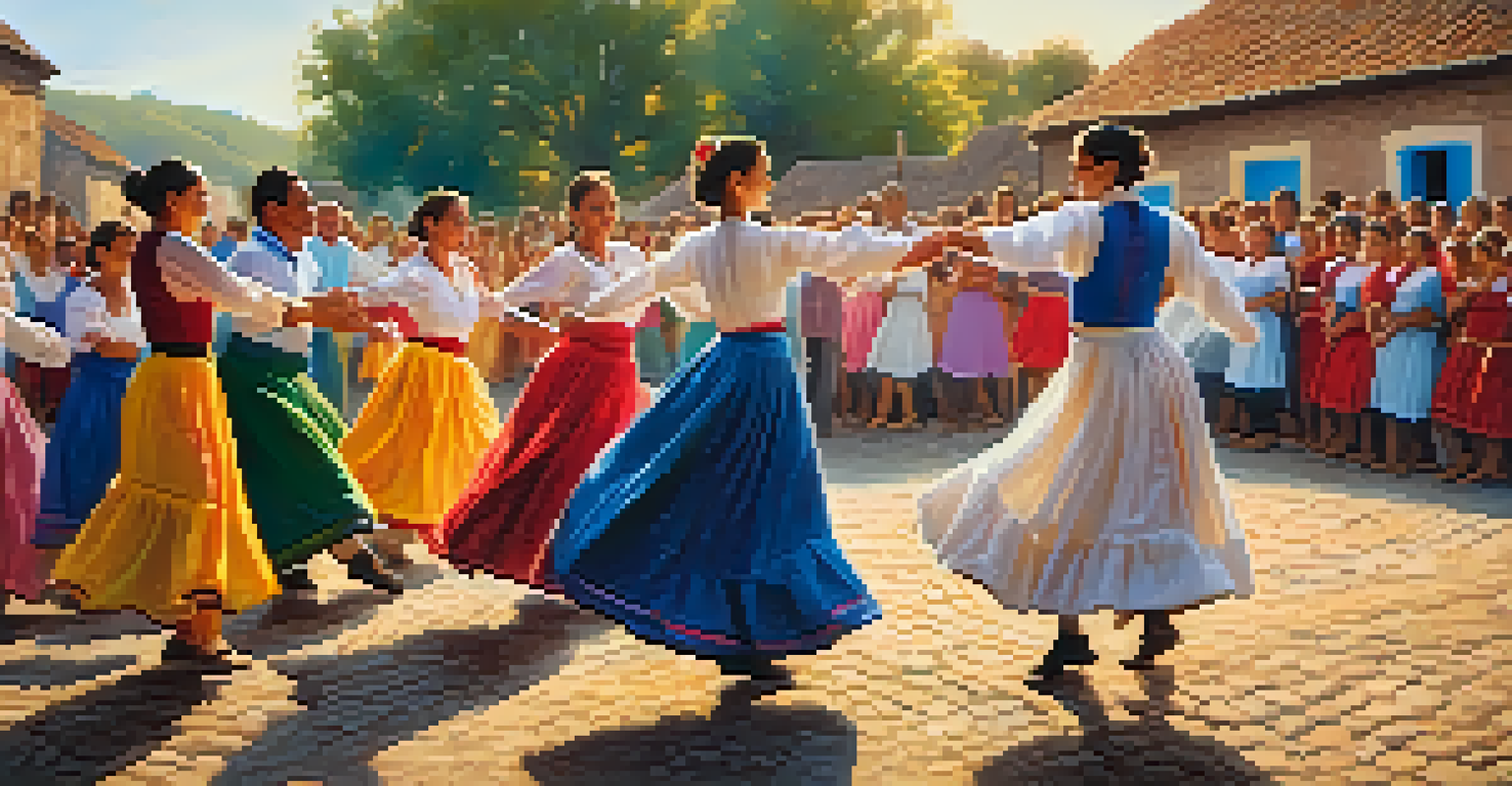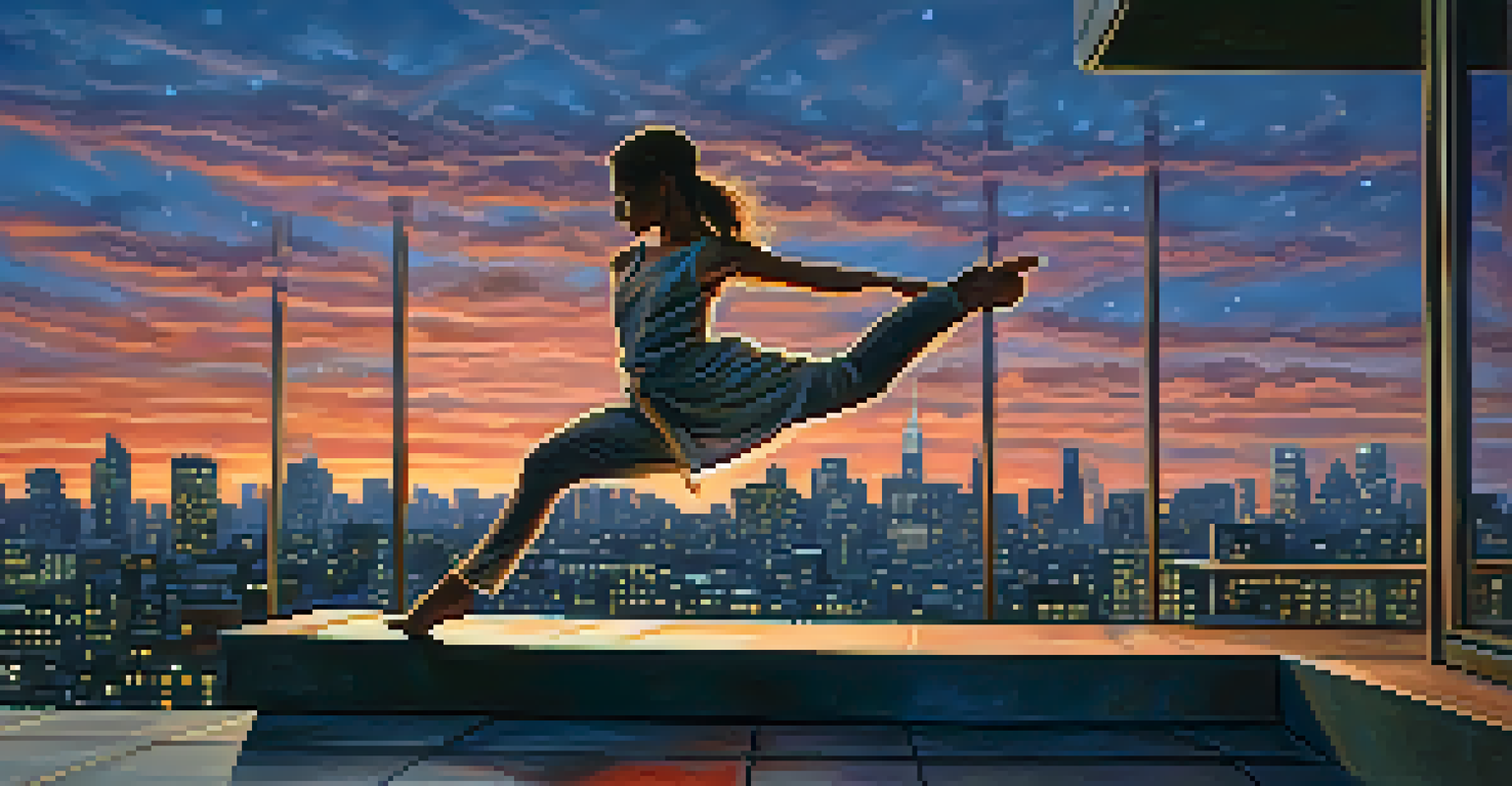Dance Movements That Tell the Stories of Our Past

The Role of Dance in Cultural Heritage and Identity
Dance is more than just movement; it's a profound expression of cultural heritage. Many traditional dances encapsulate the stories and struggles of communities, showcasing their values and beliefs. For example, the Haka dance of the Māori people not only serves as a war dance but also as a way to convey pride and identity.
Dance is the hidden language of the soul.
Through rhythmic patterns and storytelling, each dance form acts as a living archive, preserving the memories of past generations. This connection to history is particularly evident in folk dances, where every step tells a story passed down through time. It's fascinating to consider how these movements can evoke emotions and memories tied to specific cultural events.
Moreover, as society evolves, so does dance. Contemporary interpretations often blend traditional elements with modern styles, allowing for a dynamic dialogue between past and present. This ongoing evolution reflects how cultures adapt while still honoring their roots, making dance a vital part of our collective narrative.
Folk Dances: A Window into Local Histories
Folk dances serve as vibrant snapshots of local histories, often reflecting the unique experiences of specific regions. These dances often include distinct movements and music that highlight the everyday lives of the people. For instance, the flamenco from Spain captures the passion and struggles of its Andalusian roots, intertwining music and dance in a powerful narrative.

In many cultures, folk dances are performed during community gatherings, celebrations, or rituals, further cementing their significance in daily life. They create a sense of belonging and shared history among participants, reminding them of their heritage. Each performance becomes a collective memory, celebrating the triumphs and tribulations of those who came before.
Dance as Cultural Expression
Dance serves as a profound expression of cultural heritage, preserving the stories and struggles of communities.
What’s more, folk dances often evolve with time, incorporating influences from contemporary culture while still honoring their origins. This adaptability ensures that these dance forms remain relevant, allowing new generations to connect with their history. As a result, folk dances become a bridge between past and present, preserving the essence of a culture.
Ballet: The Art of Storytelling Through Movement
Ballet is often seen as a refined art form, yet it is deeply rooted in storytelling. Each choreography is meticulously crafted to convey emotions and narratives that resonate with audiences. Classic ballets like 'Swan Lake' and 'The Nutcracker' showcase timeless tales that reflect human experiences, love, and struggle.
Dancing is like dreaming with your feet.
The graceful movements and expressive techniques used in ballet serve to enhance the storytelling aspect, making it a powerful medium for communication. Through the combination of music, costumes, and choreography, ballet transports viewers to different worlds, allowing them to feel the weight of the stories being told. It’s a beautiful reminder of how art can evoke emotion and foster connection.
Moreover, ballet has evolved over the years, incorporating contemporary themes and diverse influences. This evolution not only keeps the art form fresh but also connects it to modern societal issues. By blending traditional ballet with current narratives, dancers continue to honor their past while addressing the complexities of today’s world.
African Dance: A Celebration of Community and History
African dance forms are deeply intertwined with the continent's history, celebrating community, rituals, and heritage. Each movement carries significance, often linked to cultural practices, storytelling, and social events. For instance, the traditional dances performed at weddings or harvest festivals serve to strengthen bonds within the community, reminding participants of their shared history.
These dances are often characterized by rhythmic footwork and intricate body movements, reflecting the vibrancy of the culture. They also serve as a form of communication, where dancers express emotions and messages without words. This connection between movement and meaning creates a powerful narrative that resonates with both participants and spectators.
Folk Dances Reflect Local Histories
Folk dances act as vibrant snapshots of local histories, celebrating shared experiences and community identity.
As African dance continues to influence global dance trends, it also preserves its roots through festivals and performances around the world. This blend of tradition and modernity showcases the resilience of cultural expression. By honoring their history through dance, African communities ensure that their stories are not forgotten.
Contemporary Dance: Reflecting Modern Society
Contemporary dance has emerged as a powerful form of expression, reflecting the complexities of modern society. Unlike traditional styles, contemporary dance often incorporates various influences and techniques, allowing for a diverse range of movements and themes. This adaptability enables dancers to address pressing social issues, such as identity, mental health, and political struggles.
Through its abstract nature, contemporary dance invites audiences to interpret movements in personal ways, creating a unique connection to the performers. For instance, works by choreographers like Pina Bausch and Ohad Naharin often challenge societal norms and provoke thought, encouraging viewers to engage with the underlying messages. This interaction between dance and audience adds depth to the storytelling aspect, making it a shared experience.
Moreover, contemporary dance continues to evolve, blending elements from various cultures and styles. This fusion not only celebrates diversity but also allows for the exploration of new narratives. As dancers explore contemporary themes, they keep the art form relevant, ensuring that it mirrors the ever-changing landscape of society.
Dance and Social Movements: A Powerful Tool for Change
Throughout history, dance has played a significant role in social movements, serving as a form of protest and unity. From the civil rights movement to LGBTQ+ rights, dancers have used their bodies to express resistance and solidarity. Choreographies often convey powerful messages, turning the stage into a platform for advocacy and change.
In many cases, dance allows marginalized voices to be heard and celebrated, transforming personal stories into collective movements. For example, the dance piece 'The Black Project,' created by the Urban Bush Women, explores themes of race and identity, highlighting the struggles faced by communities of color. By sharing these narratives through movement, dancers can foster empathy and understanding among audiences.
Dance as a Catalyst for Change
Throughout history, dance has been a powerful tool for social movements, expressing resistance and fostering unity.
Furthermore, the integration of dance into protests and demonstrations amplifies the emotional impact of these movements. When people come together to dance in solidarity, it creates a sense of community and shared purpose. This powerful combination of art and activism reminds us that dance can be a catalyst for social change, inspiring others to take action.
The Healing Power of Dance: Preserving Memories and Stories
Dance has long been recognized for its therapeutic benefits, serving as a means of healing for individuals and communities. Many cultures integrate dance into rituals and ceremonies, recognizing its ability to foster emotional release and connection. Whether through traditional healing dances or modern therapeutic practices, the act of moving can be incredibly restorative.
For instance, dance therapy has been used to help individuals process trauma and express emotions that are difficult to articulate. By channeling experiences through movement, participants can release pent-up feelings and find solace in a shared space. This transformative aspect of dance highlights its capacity to preserve personal and collective stories.

Moreover, as communities face challenges, dance can act as a unifying force, bringing people together to share their experiences. Group dance sessions or community performances create safe spaces for storytelling, where memories are honored and celebrated. In this way, dance becomes a living testament to resilience, ensuring that stories from the past continue to inspire future generations.